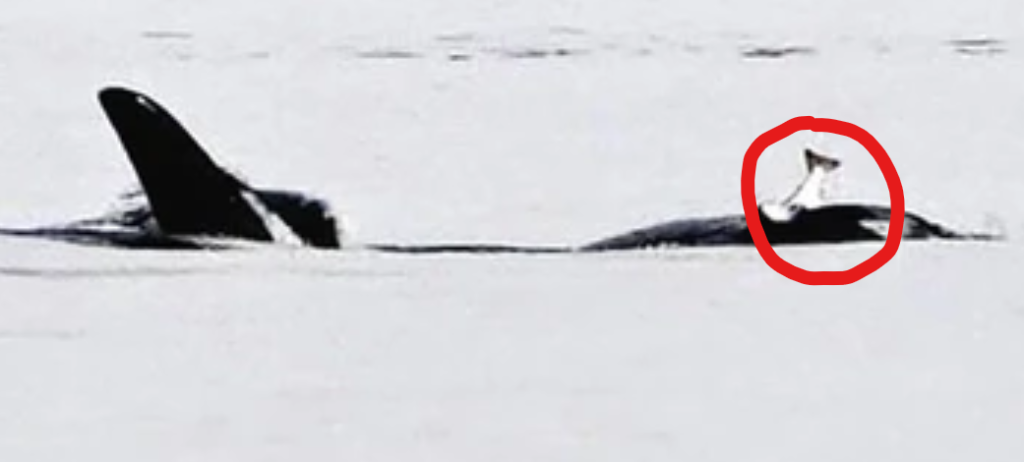Like Social Media, But For Whales?
If you’re not familiar with the terms “rizz” or “yeet” or “sus,” that’s probably because you’re on the older side of, say, 25. But to the younger generation, those all mean something. (While I have a reasonably good understanding of the terms, I’ll leave it to you to Google them. I’ve been told there are nuances that I don’t have down quite right, and I don’t want to misinform!) PopSockets are out but Octobuddies are in. And uh, well, there are a lot of other things that are cool if you’re a TikTok or Instagram-obsessed 13-24-year-old that, honestly, as someone well outside that age range, I just don’t really get.
And none of that is new. Fads — or, as they’re now called, “memes” — have been around forever and are often ridiculous. But apparently, memes aren’t unique to humans.
Just ask this orca, below (via the Vancouver Sun). If you look closely, it is wearing a salmon as a hat.
Don’t see it? Here’s a zoomed-in version, and I did my best to draw a circle around the fish on the head of the fish-like mammal.
The photo above was taken just weeks ago in November of 2024, and it’s the first time in recent memory that researchers have seen an orca with a fish hat. But it’s not the first time ever. As the Vancouver Sun reported, “The phenomenon was first noticed in 1987, when for that one year, a female from K-pod started wearing a salmon on her head. Within a few weeks, the other endangered pods, J and L, decided to try the fish-hats on as well.” Like a viral tweet, the statement spread throughout orcadom. #DeadSalmonOnMyHead, if you will.
But before 1988 had come and gone, the fish hat phase had left whaledom seemingly forever. The whales, it seemed, remembered that salmon are for eating, not wearing. As the National History Museum (UK) notes, orcas, also known as killer whales, “are apex predators, meaning they are at the top of their food chain. They feed on fish and squid like other odontocetes (toothed whales) do, but will also target seals, sea birds, and even whale species far bigger than themselves.” Orcas are known for their voracious appetites, not for their killer sense of fashion. Sooner or later, some of them were going to eat the fish, and the trend ended.
But that still left the mystery: why were orcas wearing salmon in the first place? After all, there seems to be no practical purpose for an orca to swim around with a dead fish on its head. So researchers have come up with a less-than-practical explanation: the fish are, indeed, a fashion statement, or something similar. As Andrew Trites, the director of the University of British Columbia’s Marine Mammal Research Unit told the CBC, “Maybe it’s to impress another member [of the pod]. Maybe they just like the smell of dead fish.”
Why the fish hat fad came and went in 1987, only to return after 37 years, is also unknown. Maybe it’s a human-like sense of nostalgia, or maybe a whale from 1987 is still around and remembered how much it liked wearing a dead salmon cap. Andrew Foote, an evolutionary ecologist at the University of Oslo, told New Scientist “It does seem possible that some individuals that experienced [the behavior] the first time around may have started it again.” Either way, just like human fashion, seemingly strange ideas have a way of coming back.
Bonus fact: Fashion aside, there is a lot of other evidence that orcas are very social creatures. In 1996, for example, a research team discovered an orca who couldn’t hunt for himself — some sort of accident, likely a collision with a boat — had left the whale with a severely injured dorsal fin. But the whale, dubbed “Stumpy” by the researchers, managed to survive with a little help from its friends. Researcher Tiu Similä explained the situation to National Geographic: “Instead of living with a single pod, Stumpy swims with at least five different ones, all of which feed him. Once, Similä watched as two females came dashing through the waves, each carrying a large herring for Stumpy. She thinks the orcas understand that a boat injured him, because they keep him away from boats.”
From the Archives: Gull-ible: How orcas use their somewhat-digested snacks to find themselves a bigger lunch.


